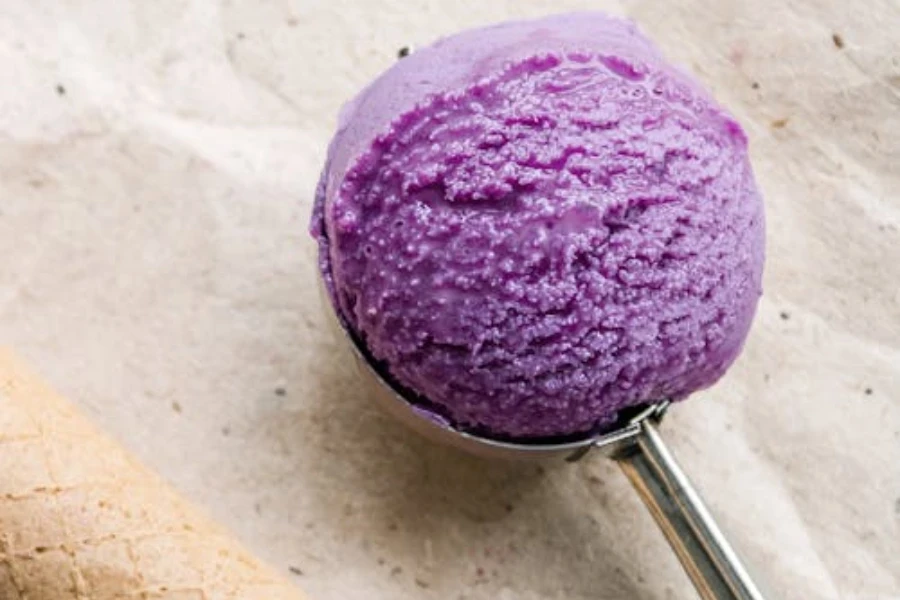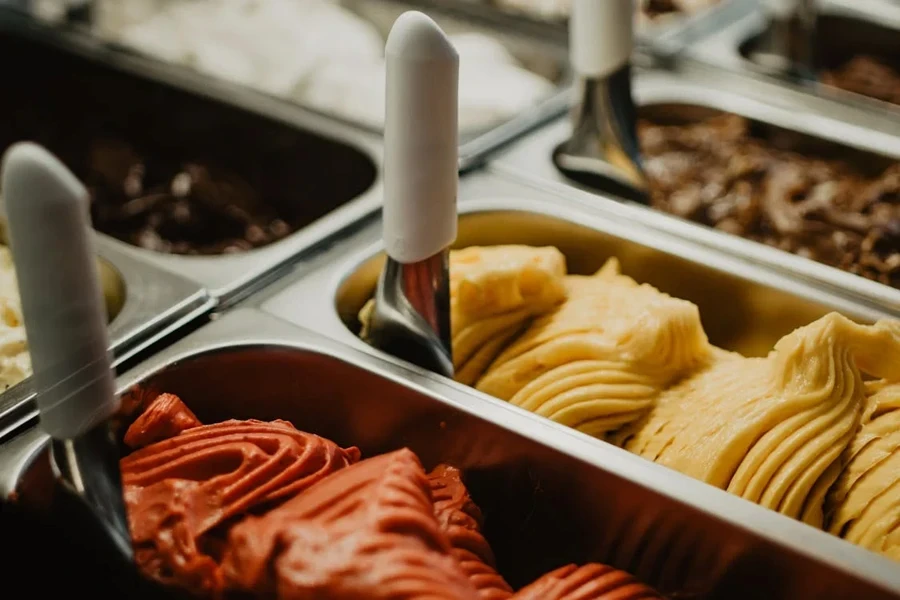In the competitive world of online commerce, selecting the right ice cream scoop can significantly impact sales and customer satisfaction. Ice cream scoops are more than just tools for serving frozen treats; they are crucial components in kitchens and ice cream parlors, influencing efficiency and the overall eating experience. High-quality scoops enhance the presentation of ice cream, effortlessly creating perfect, uniform balls of ice cream, which appeal to consumers’ aesthetic and practical preferences. By focusing on ergonomic designs and durable materials, businesses can ensure a seamless operation, reducing waste and increasing the ease of use, thereby fostering positive customer interactions and encouraging repeat business. This guide explores various scoop options tailored to meet diverse operational needs and preferences.
Table of Contents
1. Varieties and applications of ice cream scoops
2. Insights into the ice cream scoop market
3. Criteria for selecting superior ice cream scoops
4. Leading ice cream scoops: models and features
1. Varieties and applications of ice cream scoops

Ice cream scoops come in various designs, each tailored to specific needs and environments, enhancing service efficiency and customer experience in culinary settings. The selection of the appropriate scoop type can dramatically affect the operational flow, aesthetics of the served product, and even the perceived value by consumers.
Different types of ice cream scoops
The most commonly used materials for ice cream scoops are stainless steel and aluminum, each offering distinct advantages. Stainless steel scoops are renowned for their strength and durability, resisting rust and corrosion effectively, making them ideal for frequent use in busy environments. Aluminum, on the other hand, is lighter in weight and often features heat-conductive properties, which aid in easier scooping by transferring heat from the handler’s palm, softening the ice cream just enough to scoop smoothly without requiring excessive force.

Usage scenarios for various scoops
In commercial settings, the choice of scoop can depend on the volume of service and the type of dessert being served. For instance, traditional ice cream parlors and restaurants might opt for scoops with mechanical levers that facilitate quick and consistent ball-shaped scoops, ideal for fast-paced service. These scoops are often color-coded by size for portion control, ensuring uniformity in serving sizes which is crucial for inventory and cost management.
In contrast, specialty gelato shops might prefer using a spade or spatula, especially when serving artisanal gelato. This method allows for a more gentle and artistic presentation, crucial for businesses where the aesthetic and authenticity of the product serve as major selling points. Spatulas are particularly advantageous for creating attractive, layered presentations in cones and cups, crucial for enhancing visual appeal and customer satisfaction.
Moreover, the scenario in residential kitchens often differs, where practicality might take precedence over speed. Here, simpler scoops without mechanical parts—favoring ease of cleaning and storage—might be preferred. These scoops are designed to be dishwasher safe and often feature ergonomic handles to reduce the strain during use, making them suitable for home use where ice cream is scooped less frequently.
The selection process for the right ice cream scoop involves understanding these diverse applications and choosing a tool that not only meets the demands of the environment but also enhances the overall user experience, ensuring that each scoop of ice cream is as enjoyable to serve as it is to eat.
2. Insights into the ice cream scoop market

The ice cream scoop market has evolved significantly over the years, with specific trends and technological advancements shaping its current landscape. As we move into 2024, these elements are increasingly influencing both consumer preferences and the operational efficiency of these essential tools.
Experts currently value the global ice cream scoop market at US$ 76.11 billion as of 2023. It is projected to grow at a compound annual growth rate (CAGR) of 6.65% from 2024 to 2032, reaching a market size of US$ 132.32 billion by 2032. Key drivers of this growth include increased consumer spending on fast food, extensive research and development for innovative product variants, and widespread product availability. Additionally, rapid urbanization and rising disposable incomes in emerging economies are expected to significantly contribute to market expansion in the coming years. The market, which is moderately consolidated, features major global players such as Nestle, Unilever, and General Mills, who are actively expanding their portfolios and market presence through new product launches and joint ventures. Notably, the Household segment is anticipated to account for about 50% of the market share by 2031, with the U.S. and Mexico being significant contributors; the U.S. market alone is expected to reach US$ 138 million by 2029.
Current trends in ice cream scoop sales
Recent market analyses indicate a robust growth in the ice cream scoop sector, driven by rising consumer demand for both household and commercial applications. In 2024, there is a noticeable preference for ergonomic designs that facilitate easier and more efficient scooping experiences. This trend is not only improving user satisfaction but also enhancing the visual appeal of ice cream servings, which is critical in commercial settings where presentation plays a significant role in consumer choice. The market is also seeing a diversification in the types of scoops, with a clear split between those preferring traditional scoops with trigger springs for their ease of use and those opting for spade types that offer more control and finesse in scooping.
Impact of technological advancements
Technological innovations have markedly improved the functionality of ice cream scoops. Manufacturers are integrating materials that are not only durable but also incorporate heat-conductive properties to ease the scooping process. This advancement is particularly evident in the popularity of aluminum scoops, which quickly adapt to the ice cream’s temperature, reducing the effort needed to scoop hard ice cream. Additionally, the design and manufacturing processes have become more sophisticated, with a focus on creating scoops that minimize waste and optimize the scooping motion to produce perfectly rounded ice cream balls.
Moreover, the industry has seen the introduction of scoops that are easier to clean and maintain, with non-stick surfaces and dishwasher-safe certifications becoming more common. These features appeal strongly to commercial operators looking for hygienic, easy-to-maintain tools that can handle high-volume service environments efficiently. The use of technology has not only enhanced the physical attributes of the scoops but also contributed to more sustainable production practices, aligning with the growing consumer demand for eco-friendly products.
These technological advancements are setting the stage for continued growth in the ice cream scoop market, with manufacturers keen to leverage new materials and technologies to meet the evolving demands of both household and commercial users. As the market continues to expand, these innovations will play a pivotal role in shaping the future dynamics of the ice cream scoop industry, ensuring that it remains both relevant and competitive in the years to come.
3. Criteria for selecting superior ice cream scoops

Selecting the right ice cream scoop involves understanding how ergonomics and materials contribute to the tool’s functionality and durability. These factors play a crucial role in operational efficiency and user satisfaction, impacting the overall productivity and effectiveness of service in commercial settings.
Ergonomics and durability
The design of an ice cream scoop’s handle is paramount in determining its ease of use and longevity. Ergonomically designed handles not only enhance comfort but also reduce the strain on the user, which is crucial in high-volume environments. Handles that are molded to fit the hand or have a rubberized grip can significantly decrease fatigue, making the scooping process smoother and faster. Additionally, the durability of these handles, often affected by the construction and attachment to the scoop’s bowl, determines the lifespan of the scoop. Scoops designed for heavy use typically feature solid construction with no moving parts, reducing the likelihood of mechanical failure.

Considerations for materials and design
Materials play a pivotal role in the performance and longevity of ice cream scoops. Stainless steel and aluminum are the most common materials due to their durability and functional properties. Stainless steel is highly resistant to corrosion and rust, making it ideal for frequent use in moist environments. It also maintains its appearance over time, which is beneficial for businesses prioritizing presentation. On the other hand, aluminum offers a lighter weight option and often includes a heat-conductive core that aids in cutting through hard ice cream by transferring heat from the user’s hand to the scoop itself.
In terms of design, the thickness of the scoop’s bowl and its contour play critical roles in its ability to penetrate frozen desserts and release them cleanly. A thin-edged scoop can cut through ice cream more efficiently, while a well-designed bowl shape ensures that the ice cream rolls into attractive balls and releases easily. These features reduce waste and enhance the presentation, which can directly influence customer perception and satisfaction.
Moreover, technological advancements have led to the development of scoops with antifreeze handles, which use non-toxic heat-conductive fluids to ease scooping further. These innovations cater to a market where user comfort and efficiency are as important as the quality of the ice cream served. As the industry progresses, these material and design considerations increasingly define the market standards for what constitutes a superior ice cream scoop.
4. Leading ice cream scoops: models and features

The market for ice cream scoops is rich with options, but certain models stand out due to their superior performance, durability, and user satisfaction. Recent tests and consumer feedback highlight a few models that consistently excel, offering functionality that enhances both commercial and home kitchen experiences.
Top performers in the market
Among the high-performing models, the Zeroll 1020 Original Ice Cream Scoop is often favored for its ergonomic design and efficient scooping capability. Known for its unique heat-conductive handle that uses a non-toxic, water-soluble oil, this scoop slightly warms up against the user’s hand, making it easier to carve through even the most frozen ice cream. This design not only reduces the effort required but also ensures beautifully rounded scoops of ice cream. The Zeroll 1020 is lauded for its durability and has been a staple in both professional kitchens and homes for decades.
Another notable model is the OXO Good Grips Stainless Steel Ice Cream Scoop. This scoop features a sturdy stainless steel head and a comfortable, non-slip rubber grip handle that makes it easy to scoop out ice cream, regardless of its hardness. It’s particularly appreciated for its dishwasher-safe feature, making it easy to maintain and sanitize, which is crucial in commercial settings where quick and effective cleanup is necessary.

Cost-effectiveness and consumer ratings
When considering the cost-effectiveness of ice cream scoops, it’s essential to evaluate their longevity and performance against their price. The Zeroll 1020, while on the higher end of the price spectrum, is considered a worthwhile investment due to its long-lasting build and timeless functionality. Consumer ratings consistently reflect satisfaction with its performance, citing the ease of scooping and minimal effort required.
The OXO Good Grips scoop, on the other hand, offers great value for its price. It is often highlighted in consumer reviews for its robust construction and ergonomic design. Users appreciate the balance between cost and quality, making it a popular choice for those seeking reliability without a significant financial outlay.
Both scoops receive high marks for their ability to maintain their condition over time, even with frequent use. Their ratings often mention the lack of deterioration in function or appearance, underlining their suitability for busy environments where equipment durability is key to smooth operations.
Conclusion
Selecting the right ice cream scoop is vital for businesses aiming to enhance service efficiency and customer satisfaction. The choice involves understanding the different types and materials, like the ergonomic and durable Zeroll 1020 and OXO Good Grips, which lead the market in functionality. These models not only meet the aesthetic and practical demands of the service industry but also offer cost-effective solutions. As market trends evolve, staying informed on these factors will ensure businesses can strategically choose scoops that align with their operational needs and market expectations.




